| View previous topic :: View next topic |
| Author |
Message |
Josele

Joined: 10 Apr 2012
Posts: 410
Location: Tarifa, Spain



|
 Posted: Jan 07, 2020 05:14 Post subject: The concept of matrix Posted: Jan 07, 2020 05:14 Post subject: The concept of matrix |
|
|
Often the word matrix is used in mineral forums as the substrate of the main specie or most prominent crystals of a specimen, even when this substrate is another mineral specie and not the rock where these minerals have developed.
Would't be better to keep the concept of matrix as synonym of mother rock only?
| Mineral: | Fluorite on quartz |
| Locality: | | Sanming Prefecture, Fujian Province, China |  |
|
| Dimensions: | 15 x 11 x 6 cm |
| Description: |
| Would not be better to call this "Fluorite on a quartz bed" than "Fluorite on quartz matrix"? |
|
| Viewed: |
18240 Time(s) |
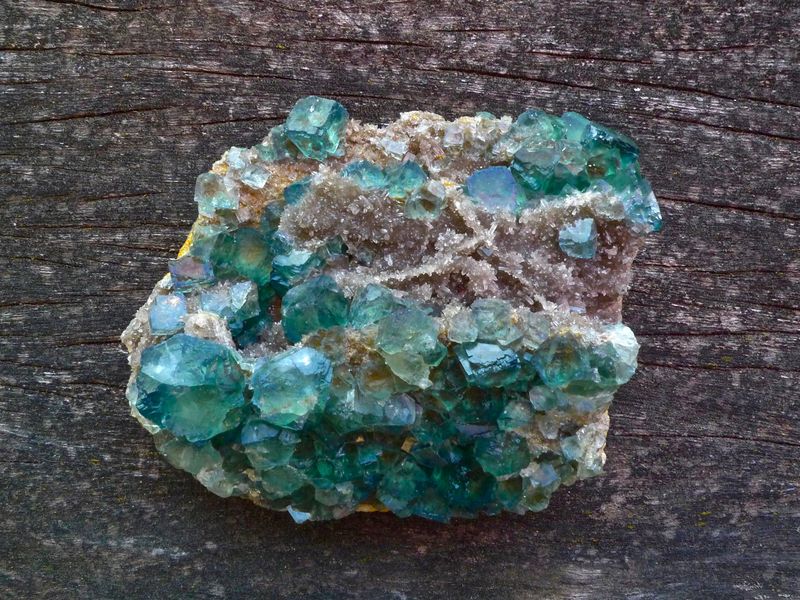
|
|
|
| Back to top |
|
 |
Bob Harman
Joined: 06 Nov 2015
Posts: 765



|
 Posted: Jan 07, 2020 06:51 Post subject: Re: The concept of matrix Posted: Jan 07, 2020 06:51 Post subject: Re: The concept of matrix |
|
|
I fully agree with Josele's concept of the word "matrix". Here in the sedimentary environment of Indiana, the matrix is almost always limestone or closely related dolostone.
When I discuss the whole specimen, I would include the limestone (or dolostone) matrix as as a part of the whole specimen, but if discussing the collector part of the specimen, I leave out the matrix, just noting the mineral(s) upon the other mineral as its bed.
Here are 2 examples of very many from my collection. BOB
| Mineral: | Dolomite on Quartz |
| Locality: | | State Route 37 road cuts, Harrodsburg, Clear Creek Township, Monroe County, Indiana, USA |  |
|
| Dimensions: | Dolomite groupings to 1 cm in a 13 cm geode, in a 15 cm specimen |
| Description: |
Dolomite on Quartz, or if noting the whole specimen : Dolomite on Quartz in limestone matrix
I usually just refer to the collector part of the specimen, leaving out the matrix. |
|
| Viewed: |
18136 Time(s) |
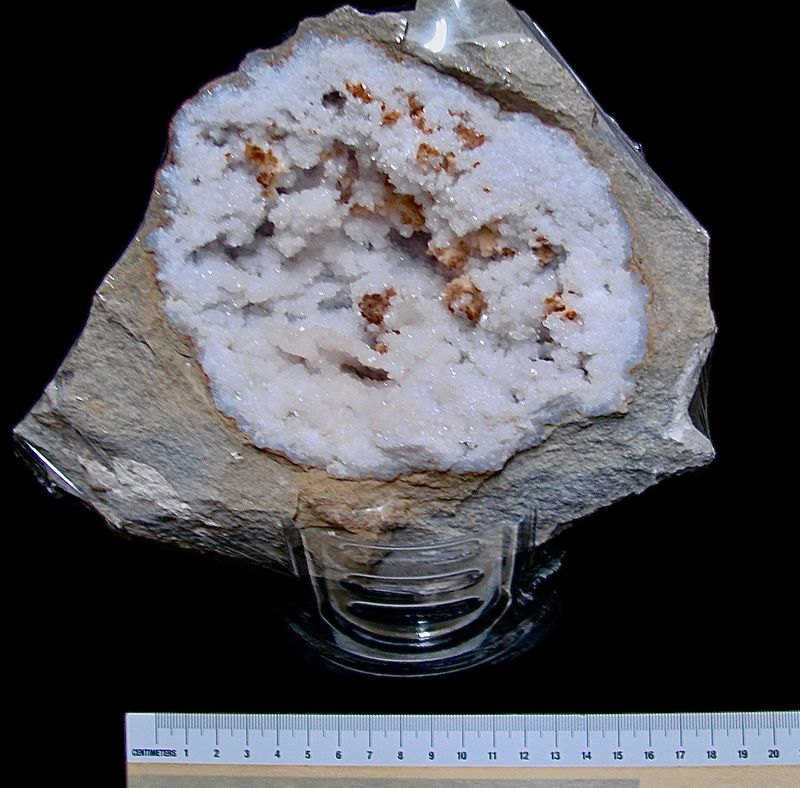
|
| Mineral: | Calcite on Dolomite |
| Locality: | | Corydon Stone Co. Quarry, Corydon, Harrison County, Indiana, USA |  |
|
| Dimensions: | Calcites to 1.7 cm in an 11 cm vug. The whole specimen is about 15 cm. |
| Description: |
| Calcite on Dolomite, or if referring to the whole specimen : Calcite on Dolomite in dolostone matrix |
|
| Viewed: |
18204 Time(s) |
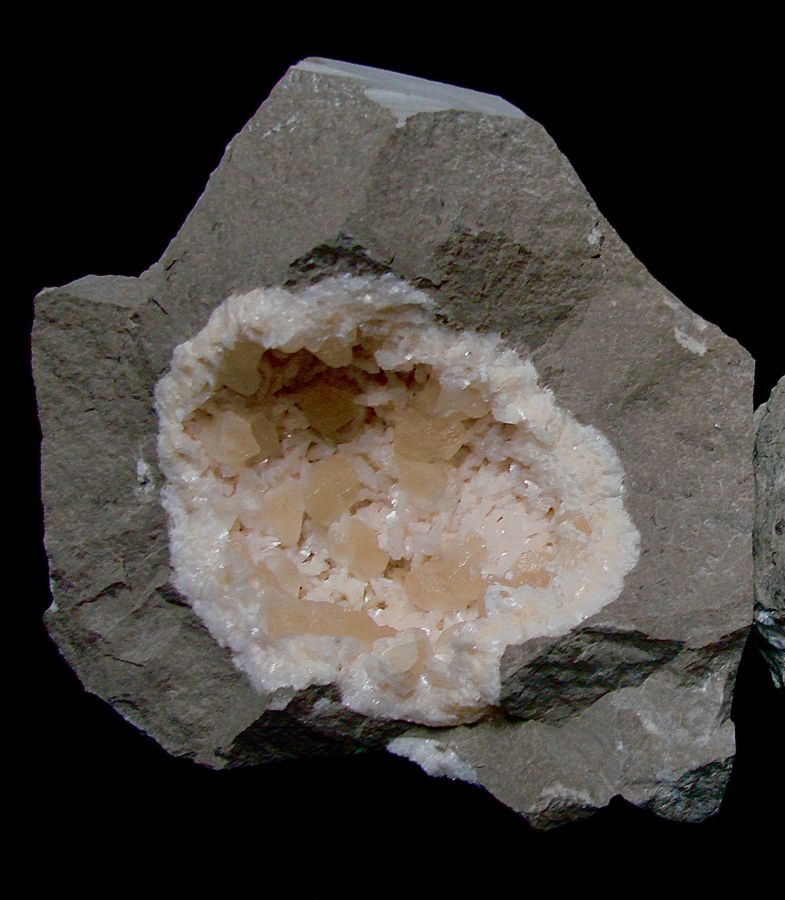
|
|
|
| Back to top |
|
 |
Kevin Schofield

Joined: 05 Jan 2018
Posts: 170
Location: Beacon NY



|
 Posted: Jan 07, 2020 10:33 Post subject: Re: The concept of matrix Posted: Jan 07, 2020 10:33 Post subject: Re: The concept of matrix |
|
|
| Josele wrote: | Often the word matrix is used in mineral forums as the substrate of the main specie or most prominent crystals of a specimen, even when this substrate is another mineral specie and not the rock where these minerals have developed.
Would't be better to keep the concept of matrix as synonym of mother rock only? |
Josele (and Bob),
I fully agree. When describing specimens "professionally" for inventory, I do not often use the word "matrix" at all. The piece you illustrate, for example, I would have as you do in your description line "Fluorite on Quartz", or maybe "Fluorite on Drusy Quartz" to emphasize the character of the underlying mineral. Bob's descriptions fit nicely with this M.O.
One occasion when I may give the matrix a nod is when there could be a stability issue as a "note to self" to be careful. Thus "Calcite on a friable limonitic matrix".
Another variant would be the co-equal presence of two "signature" minerals on a substrate of a third, which I would have as (for example in the case of a classic Elmwood Mine piece) "Calcite with Fluorite on Sphalerite".
Kevin
_________________
Veni, Vidi, Emi |
|
| Back to top |
|
 |
Jesse Fisher

Joined: 18 Mar 2009
Posts: 639
Location: San Francisco



|
 Posted: Jan 07, 2020 12:18 Post subject: Re: The concept of matrix Posted: Jan 07, 2020 12:18 Post subject: Re: The concept of matrix |
|
|
I am not sure that the terms "matrix" and "mother rock" are synonymous, as "mother rock" implies a genetic relationship and "matrix" does not. In the case of crystals developing in an igneous or metamorphic environment, there is not an outside infiltration of mineralizing solutions that are responsible for crystal growth. This is not the case in deposits of hydrothermal or metasomatic origin, where the "host rock" is pre-existing and the crystals of interest were the result of invading mineralizing solutions. The host rock is often highly altered during the mineralizing process, which may influence the chemistry of the environment in which the crystals grow, but it is not necessarily responsible for providing the basic ingredients for the crystallizing minerals.
A good example is the specimen below, a fluorite with calcite from the Heights Quarry, Weardale, England. The host rock for these mineral deposits is limestone of Carboniferous age, which was tectonically fractured and then invaded by mineralizing fluids of Permain age. The host limestone has been altered to varying degrees by this process, and in this case, the calcium carbonate that formed into crystals of calcite was likely derived from it. The fluorine necessary for the fluorite was likely derived from a deep-seated igneous source and introduced to the limestone through the circulation of heated groundwater. Sulfides such as galena and sphalerite are also common in these mineral deposits, and is thought to have formed in a similar fashion. I think that referring to the altered limestone on which the fluorite crystals sit as "mother rock" would be incorrect.
| Mineral: | Fluorite with Calcite |
| Locality: | | Heights Quarry, Westgate, Weardale, North Pennines Orefield, County Durham, England / United Kingdom |  |
|
| Dimensions: | 8x6x6 cm overall size |
| Description: |
|
| Viewed: |
18064 Time(s) |

|
|
|
| Back to top |
|
 |
Bob Carnein
Joined: 22 Aug 2013
Posts: 355
Location: Florissant, CO



|
 Posted: Jan 07, 2020 15:12 Post subject: Re: The concept of matrix Posted: Jan 07, 2020 15:12 Post subject: Re: The concept of matrix |
|
|
| I agree with Jesse Fisher. To me, the term "host rock" is more useful. Geologists generally use the term "matrix" for material surrounding and enclosing some interesting feature, such as a fossil. But, like many terms, there are inconsistencies in its use.
|
|
| Back to top |
|
 |
Josele

Joined: 10 Apr 2012
Posts: 410
Location: Tarifa, Spain



|
 Posted: Jan 07, 2020 19:14 Post subject: Re: The concept of matrix Posted: Jan 07, 2020 19:14 Post subject: Re: The concept of matrix |
|
|
Let me clarify that I used the concept "mother rock" as literal translation of roca madre which is Spanish is synonym of "host rock" (roca encajante) and also synonym of "matrix rock" (roca matriz). I don't know if in English these concepts are synonyms too.
In short I would describe Jesse specimen as "fluorite and calcite on limestone matrix" but is really better Jesse description with the explanation of his genesis.
|
|
| Back to top |
|
 |
Matt_Zukowski
Site Admin
Joined: 10 Apr 2009
Posts: 737
Location: Alaska



|
 Posted: Jan 07, 2020 19:50 Post subject: Re: The concept of matrix Posted: Jan 07, 2020 19:50 Post subject: Re: The concept of matrix |
|
|
| I believe you are right that this is a language thing. I have never heard the term "mother rock" except in talking to non-english speaking mineral enthusiasts. The term "host rock" brings to my mind a mineral deposit context. In my english context, "matrix" is the term for what we are referring to when describing something on something else. Even for syngentic material like "garnet on a schist matrix."
|
|
| Back to top |
|
 |
Vinoterapia
Joined: 03 Feb 2009
Posts: 181
Location: Houston, Tx



|
 Posted: Jan 08, 2020 09:34 Post subject: Re: The concept of matrix Posted: Jan 08, 2020 09:34 Post subject: Re: The concept of matrix |
|
|
| There is probably more than a simple question of language, but in which industry context the term is used. The Spanish term "roca madre" is widely used in the oil industry as the equivalent of the English term "source rock" ( ie. where the hydrocarbons were formed), probably in that industry nobody would use it as a synonym of "host rock".
|
|
| Back to top |
|
 |
Roger Warin

Joined: 23 Jan 2013
Posts: 1242



|
 Posted: Jan 12, 2020 15:17 Post subject: Re: The concept of matrix Posted: Jan 12, 2020 15:17 Post subject: Re: The concept of matrix |
|
|
Hi,
About the crystal support matrix.
This topic is somewhat off-topic. However, the notion of support (the matrix) comes into play.
In a glass bottle, the stopper is the only support for the occurrence of crystalline organic germs.
When the young wine is aged in the cellar, the lees are deposited and at the same time, tartar crystals appear only on contact with the cork, which by its roughness and its cellulosic nature is a favorable ground for inducing the appearance of crystalline germs from various organic salts including acidic K tartrates or sodium-potassium tartrate. Already in the old processes, chemical manipulations intervened to clarify and stabilize the wines.
These tartrates have a very weak crystalline symmetry, either triclinic or monoclinic.
| Mineral: | Sodium Potassium tartrate |
| Description: |
|
| Viewed: |
17598 Time(s) |
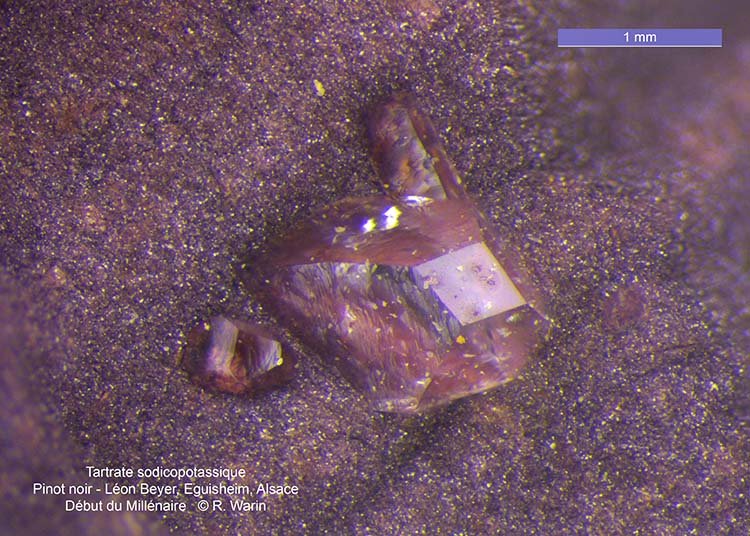
|
| Description: |
|
| Viewed: |
17612 Time(s) |
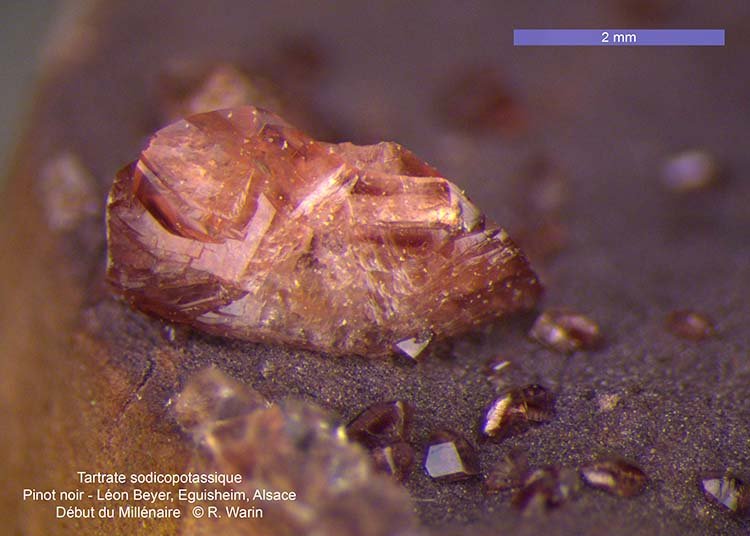
|
|
|
| Back to top |
|
 |
|





